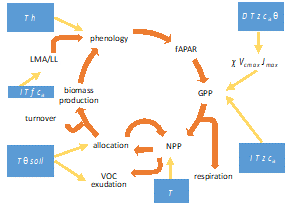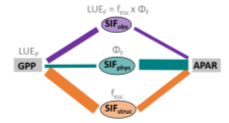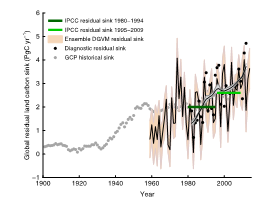The LEMONTREE project has been organised into 4 challenge areas:
Challenge 1 – Optimality at the leaf and plant levels
Challenge 2 – Biophysical coupling of atmosphere, water and land
Challenge 3 – Ecosystem properties and biogeochemical cycling
Challenge 4 – From plant function, biophysics and biogeochemistry to land-surface and climate modelling
Challenge 1 – Optimality at the leaf and plant levels We will develop a comprehensive “optimal trait theory” predicting the leading dimensions of variation in the functional morphology of plants. The theory will predict community-mean values, and variation/covariation among species, of key plant traits as a function of local environmental conditions (including CO2 – effects testable with data from FACE and controlled-environment studies). Optimality hypotheses have been successfully applied by team members to develop model components for photosynthesis, respiration, transpiration, and the leaf economics spectrum that links leaf mass-per-area (LMA) to leaf lifespan (LL).
This project will extend our work on leaf-level optimality to the whole-plant scale, including hydraulic-photosynthetic trait coordination and the adaptive control of carbon allocation. We will thereby “close the loop” that links remotely sensed fractional absorbed photosynthetically active radiation (fAPAR) to GPP, by predicting fAPAR from GPP via a series of carbon allocation steps.
 |
(D = vapour pressure deficit, T = temperature, z = elevation, ca = ambient CO2, θ = soil moisture, I = incident light, soil = fertility, f = growing season length, h = daylength.) |
Existing dynamic global vegetation models (DGVMs) and some ESMs already predict this set of processes. But they do so inaccurately, with ad hoc equations standing in for theory. We have good reason to anticipate that this project will identify more soundly based solutions. For example, we have a theory for VOC emission; we have shown that maximum vegetation cover is tightly constrained by growing-season warmth in cold climates, and by rainfall in dry climates (see above); we have presented evidence for simple, consistent phenological patterns, and a robust relationship between NPP and GPP.
Challenge 2 – Biophysical coupling of atmosphere, water and land We will develop a comprehensive theory describing how ecosystems regulate water and energy exchanges between the atmosphere and land, leading to the construction of a model for water, energy and momentum exchanges at the land surface that will reproduce spatial, seasonal and interannual variations of site-based latent heat fluxes as measured at eddy-covariance sites and, when scaled up to catchments and the globe, account for observed large-area patterns in land surface temperatures and streamflow on these different time scales.
Challenge 2 will build on the team’s previous research characterizing spatial patterns of biophysical land-atmosphere feedbacks (left: fraction of variance in biosphere-atmosphere coupling explained by feedbacks between precipitation – or photosynthetically active radiation – and GPP, as indexed by SIF). Team members have also shown that daytime LST over intact, moist tropical forests is systematically lower than air temperature, due to transpirational cooling (current models struggle to reproduce this phenomenon); that ecosystem responses to CO2 in semi-arid regions, which include “greening”, have led to reduced streamflow (in other words the greening response – implying increased ET – outweighs the effect of reduced stomatal conductance on ET, which is the dominant effect in most models); and that good predictions of transpiration can be derived, using remotely sensed fAPAR as input to our optimality-based model for GPP, based on the tight coupling of transpiration and GPP via stomatal conductance.
|
Team members have been active in studying the properties of remotely sensed SIF as a proxy for GPP, including the development of a new SIF product, and the demonstration that SIF as observed combines chlorophyll fluorescence (linked to photosynthetic electron transport) with re-absorption and scattering of the emitted light by vegetation. |
 |
Challenge 2 will thus be based on state-of-the-art theory and observations in both the physical and biological domains.
Challenge 3 – Ecosystem properties and biogeochemical cycling We will create a model for land carbon cycling that will not only reproduce spatial, seasonal and interannual variations of site-based CO2 exchange as measured at eddy-covariance sites, but also – when exercised globally – account for observed spatial, seasonal and interannual variations of atmospheric CO2 and its naturally occurring isotopes 13C and 14C.
The model will be forced by observed fAPAR initially, progressing to a full prognostic capability as successive Challenge 1 tasks are addressed. We will strive for the minimal representation necessary to reproduce observations at the different scales. As research has cast serious doubt on the paradigm of soil organic matter (SOM) dynamics that separates chemically distinct SOM “compartments”, we will take a different approach to below-ground carbon dynamics: seeking a simple model to explain geographic patterns of SOM (which are very poorly simulated by current models), while also consistent with atmospheric data. We will maintain an option to include new conceptual advances in SOM modelling.
| Instead of trying to represent all known processes, our approach is thus to seek the minimum set of processes needed to explain the available observations – which now amount to a very strong set of constraints. As an example of our work in this mode: we have shown that key features of the recent history of land carbon uptake can be explained by coupling a model of total ecosystem respiration (based on analysis of CO2 flux measurements) to our optimality-based GPP model. (right – black dots) |  |
The performance of this hybrid model rivals that of complex DGVMs.
Challenge 4 – From plant function, biophysics and biogeochemistry to land-surface and climate modelling Findings from Challenges 1–3 will be implemented in a global modelling context with a two-part strategy:
New formulations will be tested offline in the VIC+ land-surface model framework, allowing many model runs and sensitivity analyses to be made without excessive computational costs; and included in the UK Earth System Model (UKESM) – first offline in the land-surface component (JULES), then coupled to the atmosphere. VIC+ is set up for offline operation. Its predecessor VIC, widely used in impact studies, has an exceptionally good track record in reproducing observed hydrological data due to the adoption of innovations in hydrological modelling, including the representation of sub-grid scale variability in soil properties, and the treatment of surface water and groundwater as a continuum. VIC+ further represents the interdependence of plant photosynthetic and hydraulic properties, including biophysical constraints on transpiration (water flow through tree stems equals water loss from leaves, which in turn is directly coupled to CO2 uptake); hydraulic redistribution within the soil column by plant roots; and water storage in stems. JULES is set up for straightforward testing of alternative versions in both free-standing and coupled modes. Ancillary data sets permit offline simulations at high resolution (5–10 km2), facilitating comparisons with many kinds of data. Both modelling frameworks allow “tiling” of grid cells and (for carbon cycle applications) the possibility to represent vegetation dynamics, disturbance regimes (most importantly wildfire), and land use. Vegetation dynamics will exploit a recent breakthrough in modelling ecosystem demography which greatly reduces computational demands relative to earlier, individual- or cohort-based models.
The final step of Challenge 4 will be to assess the implications of an improved land-surface representation for simulated climate in the UKESM, based on historical simulations (from 1850-2016 CE) following CMIP6 protocols. Evaluation will focus on precipitation, evapotranspiration and temperature.
Α key innovation required for Challenge 4 is the explicit coupling of fast biophysical exchanges to slower, optimality-based acclimation processes.
A proof of concept is shown below. Combining the acclimation timescale (15 days) for the stomatal set-point and photosynthetic capacities with the fast timescale (½ hour) of stomatal dynamics and photosynthesis in a model (red) for GPP allowed close mimicking of observed (grey) GPP: shown here for a week in 2003 at the University of Michigan Biological Station flux site (Sandy Harrison, Colin Prentice, in collaboration with the European Centre for Medium Range Weather Forecasting, Reading).
This demonstration represents a step-change improvement in the realism of the ECMWF land-surface model.

(Images courtesy of LEMONTREE project team).
For paper references, please contact r.a.phipps@reading.ac.uk
